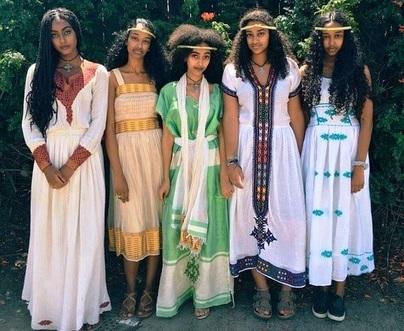
Ethiopian Weaving
Learn All About Ethiopian Weaving
Hand Loom Weaving
Fabrics are woven on looms using distinct sets of yarns or threads that are interlaced at right angles.
In most of the industrialized world, weaving artisans are dying out, due to the increased use of the power loom
Spinning
Women spin the cotton into thread that's loaded onto spools and then strung onto the loom's warp (lengthwise thread) and weft (the thread that weaves in and out of the warp thread).
The sound of handloom weaving is unmistakable.
The shush of the flying shuttle - a small missile-shaped object, often fashioned from dogwood, that holds the weft thread - as it's thrown through the shed, or warp threads. The slam of the beater. The click of the heddle.
Weaving Process
Weavers commonly use two different types of looms.
The first is the meweroria, where the weaver throws the bobbin side to side.
The other type is the ground loom. With the ground loom, a hole is dug on the ground and the weaver moves the shuttle with his feet alternately up and down to interweave the threads.
Hand-woven cotton garments also called shemma were traditionally worn by the Christian populations of the northern and central highlands of Ethiopia and the central and southern highlands of Eritrea.
Today the hand-woven cotton garments are found nearly everywhere in both countries and are not only used for garments but also for household products like blankets, cushion covers and table covers.
The handloom weaving was established to meet household need and demand for clothing, and then gradually grew to be an additional source of income.
The home-based traditional handcraft industry is pivotal for the cotton industry.
In fact, the traditional hand-weavers are the major demanders of raw cotton, and are engaged in weaving and preparation of traditional fibers for the local and export market.
There was no imported textile sold in Ethiopia for a long time due to the high valued textiles of the local market.
Today the weaving industry in Ethiopia is the most important non-agricultural source of income in the country particularly for rural families after agriculture.

In both urban and rural areas, there are strong patterns of geographically clustered handloom activities.
Each area of a city or a village has at least one weaver in residence. Weaving communities still exist in areas such as Shiro Meda or Gulele in Addis Ababa.
The weaving is operated predominantly by male craftsmen while the cleaning and spinning is done by women.
However men are also known to spin in some areas of Ethiopia.
The weaving is a specialized craft, spinning of the white cotton is done by all classes of women and continues to contribute to the family income.
Also elderly women spin for home use or just for pleasure.
According to Pankhurst the first weavers were Muslims and Falashas (Ethiopian Jewish) who travelled with the "moveable courts" and set up their looms on the verandas of the homes of noblemen.
Today the Konso and the Dorze ethnic groups from the highlands of the South-western of Ethiopia have the reputation to be the most skilled weavers of the country.
Weavers used to have a marginalized status in Ethiopia as well as in Eritrea.
However today weaving provides a steady income and the skill of talented weavers is highly in demand.
The color of the woven cotton which is used for all kinds of dresses for men and women was traditionally white.
Until recently the attempts to introduce different colors for the cotton failed because the colors were not colorfast.
The borders of the cotton garments can be plain or decorated with the so called tibeb for which cotton, silk, metallic, rayon, acrylic and wool yarns are used for the design.
Most weaving now is done with rayon floss or twisted "art silk" imported from India, China and Japan.
Some weavers however use pure silk imported from England.
